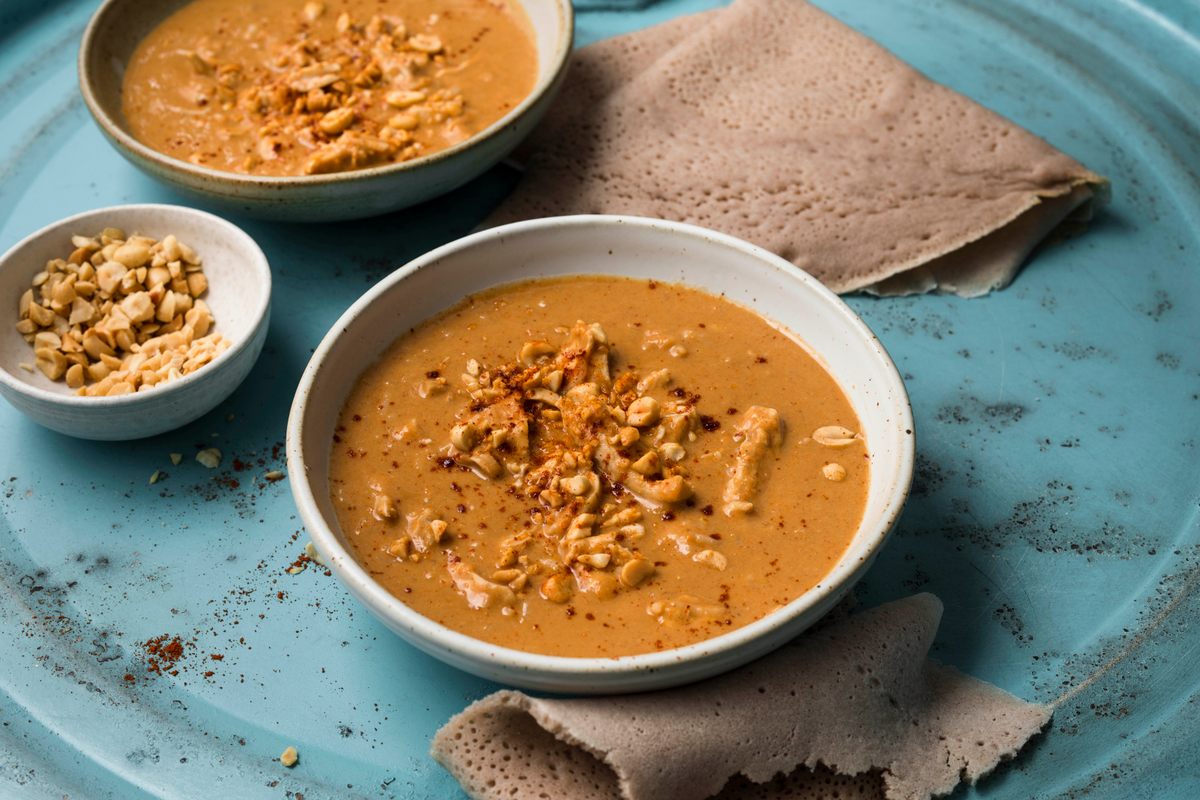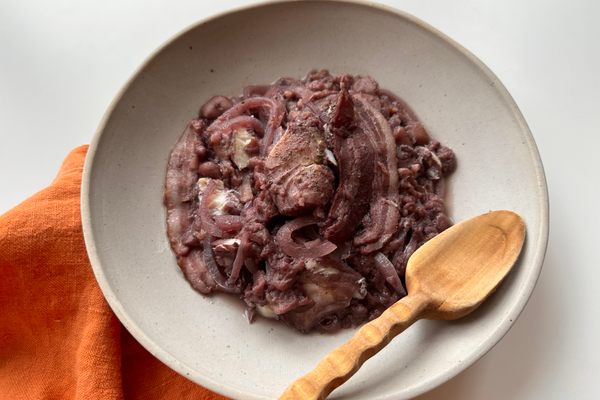Around the World in 130 Chicken-Soup Recipes
A new cookbook is devoted entirely to the soothing, healing meal.
On a brisk autumn flight from San Diego to Portland, Oregon, cookbook author and chef Jenn Louis was suffering from a particularly bad cold. Achy and exhausted, she came home to find a giant pot of chicken soup on her porch, lovingly prepared by her sister Stacy. As she gulped down three bowls, Louis felt the rich, soulful flavors improve her mood. The hearty, familiar taste made her think about the chicken soups of her own Jewish upbringing, as well as the ubiquity of chicken soup across culture, race, and class.
“Every culture thinks their chicken soup is the chicken soup,” says Louis. “Every culture says that chicken soup is what heals them.”
Louis began thinking about chicken soup almost daily. Already the author of two books, Louis decided to dig into the role of chicken soup across the world. Her new book, The Chicken Soup Manifesto: Recipes from Around the World, highlights some of the essential chicken soups of the globe.
“We express our cultures, feed our nations, and convey our most treasured flavors through this delicious and humble soup,” writes Louis in her new book.

Spanning multiple regions and countries—touching Africa, the Americas, Asia, and Europe—Louis provides geographical, social, political, and cultural context for more than 130 soup recipes that have fed various communities for centuries. Pushing beyond the limits of traditional chicken soup, she includes recipes for hearty, conventional chicken-filled broths and soups or porridges that include chicken alongside other key proteins. From the aromatic, Filipino dumpling-soup pancit molo, which includes pork, shrimp, and shredded chicken and invokes Chinese, Spanish, and Filipino culinary traditions, to the steamy, vegetable-friendly Yakhni that is prepared in unique ways across the Middle East and South Asia, Louis illuminates the complex history of trade and colonization that has impacted the foodways of nearly every country featured, as well as the cooking traditions that have soothed and healed communities across the globe.
“I love the whole idea of understanding culture through food,” says Louis. “You can learn to love and understand a culture through its food, hospitality, warmth, and experiences.”
Louis sees chicken soup as an example of humanity’s commonalities and the healing nature of our food. An avid traveler, Louis enlisted the help of friends and family on social media to decide which soups to test and explore in her cookbook. A friend from Sri Lanka suggested a fragrant kanjee that is often enjoyed after breaking the Ramadan fast, while a woman who immigrated to the U.S. from Greece shared with Louis her recipe for avgolemono, a citrusy, eggy soup that’s a silky trip to the Aegean in a bowl. This global approach, Louis says, was essential to capturing the diversity and cultural nuances that define chicken soup. The book can also transport readers to other parts of the world amid a global lockdown, a reality Louis didn’t anticipate during the writing, but is grateful for now.
“It’s interesting that it came out during this time,” she says, “because with COVID keeping us at home, this book allows people to open their mind by trying new things, and to travel by thinking about food.”
Trying Louis’s recipe for Ye Ocholoni Ina Doro Shorba, a creamy peanut-butter soup with bite-sized chunks of chicken, I reminisced about my previous trips to West Africa, which included bowls of groundnut (peanut) soup, and experienced a bit of my of my spring trip to Ethiopia that was cancelled due to COVID-19. The aroma of the Ethiopian spice blend berbere filled my kitchen with warmth and comfort, and the creamy, peanut butter blend soothed my stomach on a particularly cold New York City evening. It’s one of many recipes that capture the universal ability to convey culture and comfort through a bowl, a needed characteristic during what many have described as a daunting year.
“We all have a different idea of what chicken soup is,” says Louis, “but the commonality is that most people say that it’s what heals them.”
In the cookbook, Louis blurs the line between soup and porridge, sharing recipes for all hearty, stocky, and brothy concoctions built around chicken. While her recipes are researched and tested, with pantry necessities and cooking tips to help readers (don’t skip out on the homemade chicken stock!), Louis encourages readers to get comfortable with experimenting and to find ways to use what they’ve got.
“It’s chicken soup,” she says. “It shouldn’t be difficult.”

Ye Ocholoni Ina Doro Shorba
Recipe excerpted with permission from The Chicken Soup Manifesto by Jenn Louis, published by Hardie Grant Books, September 2020.
Serves 6
Variations of peanut soup are popular throughout East and West Africa. Ingredients will vary depending on the region, adding or subtracting collard greens (spring cabbage), chickpeas, tomatoes, spices, and squash. It is a hearty and flavorful soup, rich from the peanut butter and spicy from the berbere.
2 tablespoons rendered chicken
Fat or vegetable oil
2 yellow onions, cut into 2 cm (¾ in) cubes
2 carrots, cut into 2.5 cm (1 in) rounds
1 sweet potato (about 450 g/1 lb), peeled and cut into 2 cm (¾ in) cubes
2 tablespoons Berbere (see opposite), plus extra to garnish
1 tablespoon salt
1.9 liters (64 fl oz/8 cups) water or Chicken Stock
450 g (1 lb) boneless, skinless chicken breasts or tenders
255 g (9 oz/1 cup) natural smooth peanut butter
65 g (2¼ oz/⅓ cup) basmati rice
30 g (1 oz) chopped roasted peanuts, to garnish
Melt the chicken fat or oil in a large pot over a medium–high heat. Add the onion, carrot, and sweet potato and cook for 3–4 minutes until the onion becomes translucent. Stir in the berbere and salt, then add the water or stock and bring to a very gentle simmer. Place the chicken in the soup and cook gently until just cooked through, 2–3 minutes for the tenders and 6–8 minutes for the breasts. Remove the chicken from the soup, then continue cooking at a gentle simmer for 8–10 minutes until all the vegetables are very tender. Cut the chicken into bite-sized pieces and set aside on a plate.
Using a blender or an immersion blender, purée the soup with the peanut butter until very smooth. If using a blender, take care to remove the center piece on the blender cover—the hot soup will splatter without a vent. Pour the soup back into the pot; it will be thin. Add the rice and cook at a very slow simmer, stirring with a whisk, for 10 minutes, or until the rice is tender. Make sure the rice does not stick to the bottom of the pot and that the soup does not become too thick and burn. Thin the soup with a little water or stock as needed.
When the rice is cooked, season with salt and ladle into bowls. Garnish with the chicken pieces, a sprinkle of berbere ,and peanuts.
Berbere Spice
Makes 35 g (1 ¼ oz)
6 green cardamom pods
8 cloves
1 teaspoon coriander seeds
½ teaspoon ground allspice
½ teaspoon fenugreek seeds
1 tablespoon chili powder, such as ancho or New Mexico
1 tablespoon salt
1 teaspoon ground ginger
¼ teaspoon ground cinnamon
Place the cardamom, cloves, coriander, allspice, and fenugreek in a small pan and toast over a high heat, making sure not to burn the spices, until fragrant. Set aside to cool.
When cool, grind finely in a spice grinder or coffee grinder, transfer to a bowl and stir in the remaining ingredients. Store in an airtight container for up to 6 months.
Gastro Obscura covers the world’s most wondrous food and drink.
Sign up for our email, delivered twice a week.


















Follow us on Twitter to get the latest on the world's hidden wonders.
Like us on Facebook to get the latest on the world's hidden wonders.
Follow us on Twitter Like us on Facebook